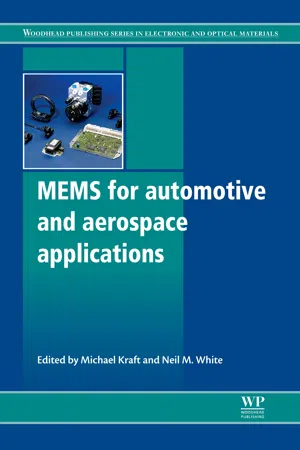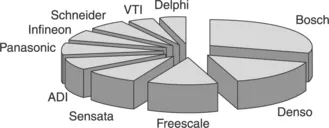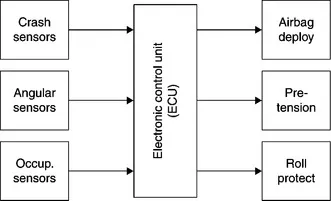Abstract:
Passenger safety is a high priority for vehicle manufacturers and over recent decades many advances have been made in a number of technologies to more effectively implement protection devices. This chapter starts with an overview of the rationale behind safety systems, introduces the protection systems employed against crash and rollover events, and then focuses on three sensing devices used in such systems, which have been implemented adopting MEMS technology. Much research and development effort continues to create novel safety systems. This chapter finishes by reviewing progress in the three distinct areas of passenger monitoring systems, vehicle monitoring systems and environment monitoring systems.
1.1 Introduction
MEMS (Micro-electromechanical systems) implemented in automotive electronics began in the early 1980s with pressure sensors for engine management systems. In the early 1990s, this technology was introduced to safety systems with the implementation of accelerometers (Fleming, 2001, 2008). Over the decades, MEMS technology has found many applications within the motor car, enabling innovative electronic systems and the reduction of production and assembly costs of safety systems.
Passenger safety is a high priority for the vehicle manufacturer, often making it a selling feature for the vehicle. Many advances have been made in a number of technologies to more effectively implement protection devices to ensure the safety of occupants in a crash event.
The World Heath Organisation reported in 2007 that Western Europe, Canada, Australia and Japan have some of the lowest death rates per annum caused by vehicle crash events. These are between 4.8 per 100 000 persons for the Netherlands (UK 5.4) to 10 per 100 000 persons for Iceland. The USA has a death rate of 13.8 per 100 000 persons compared with Eastern Europe, for example with Bulgaria at 13.2 per 100 000 and Poland of 14.7 per 100 000 persons. Some of the worst death rates are in North Africa, with around 40 per 100 000 persons per annum. Causes of such crash events are made up of a mixture of road and vehicle conditions, and driver behavior.
Road fatalities in the UK started to decrease in the early 1970s, from 7500 deaths per annum, with the introduction of speed limits, annual vehicle testing (the MOT) and other measures, to less than 6000 death per annum in the early 1980s. Further reductions have occurred during the introduction of the compulsory use of seat belts and the development of vehicle safety systems to less than 2500 deaths per annum in recent years. The UK Department of Transport reports that 1850 persons were killed on the roads in 2010. This reduction is mirrored in other countries with the US Department of Transportation reporting that 32 788 persons were killed in 2010, which is a death rate of 10.6 per 100 000 persons.
The reduction in deaths cannot simply be explained in terms of one or two improvements in road conditions or vehicle performance, but consists of a complex mixture of many factors. An important factor is the development of vehicle safety systems and along with this are the developments in MEMS sensors.
Frontal crash, side impact and rollover are the main events that a safety system has been developed to deploy protection devices. MEMS sensing devices are used in such systems to detect the condition of the vehicle in terms of undesirable accelerations and angular rate changes, as well as the detection of the position of occupants. Research and development effort continues worldwide on creating novel safety systems by monitoring passenger position and behavior, vehicle behavior and environmental conditions.
The main suppliers of MEMS for the automotive industry are identified in the chart in Fig. 1.1, showing their market share in terms of sale value worldwide. Bosch dominates but there are multiple companies involved in MEMS production as illustrated by the chart, which is not an exhaustive list of players.
1.1 Market share of automotive MEMS in 2009 (source: Marek 2011).
1.2 Passenger safety systems
A vehicle manufacturer, such as Daimler AG (Mercedes-Benz), has classified their safety systems into several technological domains. ‘Prevention’ technologies help the driver to become more aware of road conditions, as well as minimizing driver distractions and stress. For example, radar and cameras improve visibility. ‘Response’ technologies assist the driver when things start to go wrong. For example, anti-lock breaking (ABS) improves breaking and steerability. ‘Protection’ technologies are designed to mitigate the consequences of accidents for the passenger and other road users. For example, restraint systems minimize injury to the passenger. The final domain is ‘rescue’ technologies for helping the emergency services.
1.2.1 Passenger protection systems
Electronically controlled passenger protection systems are commonplace in most vehicles to some degree. These consist of various airbags, seat belt pretensioners and rollover protection devices, all controlled by an electronic control unit(s) (ECU). These systems are typically integrated into one centrally controlled system made up of the following component parts:
• Sensors:
– for indicating an event, which may require action.
• The ECU:
– for signal processing to identify the critical event that requires action;
– for supplying the appropriate signals to deploy the protection device;
– for system diagnostics to ensure robust behavior.
• The protection device:
– for delivering the appropriate protection.
Figure 1.2 illustrates this system consisting of a sensing part, a control unit and an actuation part. Three types of protection devices are shown in this example, for airbag deployment, pretensioner firing and rollover protection. Also three types of sensing devices are shown, each of which is the focus of this chapter concerning crash sensing, vehicle rollover and occupant detection.
1.2 The protection system.
1.2.2 The crash event
A vehicle in a crash event is usually undergoing a rapid change in velocity in some direction caused by contact with an external obstacle. In a frontal collision of the moving vehicle, there is a rapid deceleration of the vehicle, whereas an unrestrained occupant continues to move forward until abruptly stopped by contact with a rigid part of the interior of the vehicle (such as a steering wheel or windscreen). Any protection system employed looks to ensure smooth deceleration of the occupant to minimize injury. Pretensioned seat belts and airbags are designed specifically to achieve this.
Pretentioners on seat belts are fired by igniting a pyrotechnic charge in the frontal crash event to maximize the restrain of the occupant with the use of the seat belt. This tightens the seat belt to prevent the occupant from jerking forward, which typically takes between 5 and 10 ms (Jurgen, 1999).
Depending on the specification of the vehicle, there are numerous arrangements of airbags and curtain systems. The frontal airbag is the most standard, which is placed in the steering wheel or dashboard to restrict frontal motion of the occupant. Pyroelectric igniters activate gas generators to inflate the airbag within around 30 ms (Jurgen, 1999).
Rollover protection such as roll-bars (Wanden and Kinnanen, 2001) and headrest-bars (Hehl and Remm, 1999) are...


